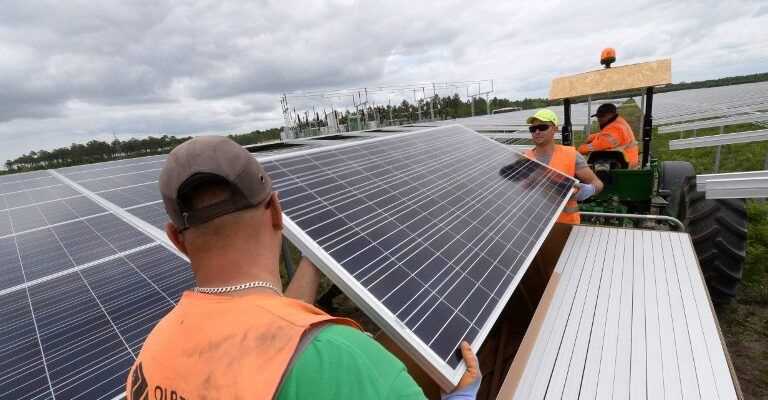(BFM Bourse) – The current energy transition is radically different from the previous ones: for the first time, humanity is seeking to produce more energy with less carbon. Investors are still struggling to understand the financial effort that this completely unprecedented transition will require.
In the past, energy transitions consisted of developing technologies that allow access to more carbon-based energy with less effort, thereby removing obstacles to economic growth arising from insufficient sources of energy. From wood to fire, man switched to charcoal and then to petroleum, the unparalleled energy density of which allowed unprecedented economic development during the 20th century.
But the energy transition in question today is completely different, explains Norman Villamin, head of investments for private management at Union Bancaire Privée, in a note on the subject. For the first time, humanity is seeking to produce more energy with less carbon. To accomplish this Herculean goal, considerable effort will be required during the early years of the transition.
Green energy offers the promise of zero marginal costs. However, the technologies likely to decarbonise the energy value chain (wind, solar, batteries) are still far from replacing all the infrastructures based on fossil fuels. After twenty years of solar and wind development, the latter only represent … 3.3% of overall final energy consumption, a rather modest result, underlines the Geneva private bank.
Previous energy transitions have lasted for years, if not decades, and that’s without counting the challenges posed by the transformation to come. In other words, says UBP, expect more complexity, and increased volatility. “The complexity and volatility will be determined by how responsive and hopefully the economy is anticipation to meet future challenges, spark innovation, and create value in the wake of the value destruction that the transition will inevitably involve “.
Insurance premiums that anticipate extreme risks
For the time being, the approach to climate issues remains essentially reactive. Indeed, the IPCC estimates that temperatures are already 1.2 ° Celsius above pre-industrial levels, a level very close to the threshold of 1.5 ° C not to be exceeded in the next two decades. Faced with the still recovering global economy, the reactive approach, although alarming, is understandable in the sense that it lightens, in the short term, the burden on economies hard hit in recent years.
However, as extreme weather events increase, markets anticipate future climate changes. Concrete example cited by Norman Villamin: given the increased frequency of hurricanes and floods which affect more and more regions in the United States, insurance premiums will increase by 77% for the approximately 5 million participants in the ‘ National Flood Insurance Program ‘. Likewise, in Europe, banks tend to reduce access to credit due to climate impacts.
These developments lead to infrastructure spending to mitigate the effects of future weather events. For companies offering such solutions, these previously ad hoc opportunities turn into rents as these expenses become recurring and fuel their growth.
In addition, continues the manager, in this period of replacement of carbon-based energy, the transition will require more energy in the short term while the current energy crisis is forcing some countries to switch back to high-carbon fossil fuels. carbon, such as coal. However, the crisis is triggering backlashes from consumers, for example, investing in solar panels to avoid grid failures if the fossil fuel race continues.
Decades of growth in sight for some players
Fortunately, these reactive measures could be accompanied by proactive measures taken by manufacturers using wind and solar power or batteries on an industrial scale. Decades of growth lie ahead for those with the capacity to build, install and operate renewable assets, and the associated infrastructure, even as scaling up is not easy and the challenges of tomorrow. can be difficult to identify today, prognosis Norman Villamin.
In contrast, development models that rely entirely on fossil fuels are doomed to extinction in the long term, but companies have a unique chance to change their structure. Many oil and gas companies are in precisely this situation. In fact, the current energy crisis prompts them to act by using the benefits generated by fossil fuels to redeploy their traditional investments in favor of renewable assets, which would allow them to play a decisive role in the energy transition. Otherwise, structural decline will prevail and their previously productive assets, which generate cash flow, risk turning into stranded assets.
While companies can take charge of the energy transition (more and more of them are doing so), governments and politicians will also have an important role to play – beyond the regulatory pressure that they exercise to stimulate transformation – by lowering investment risk.
To achieve carbon neutrality by 2050, replacing the world’s energy infrastructure would require, according to some estimates, as much as $ 50 trillion – more than the investments that have allowed China to industrialize over the years. last decades. Just as Beijing has taken advantage of falling interest rates to cheaply finance its ambitious spending programs, policymakers may need to come up with attractive financing costs to incentivize the private sector to invest and innovate on a scale beyond. reach of governments.
Guillaume Bayre – © 2021 BFM Bourse
